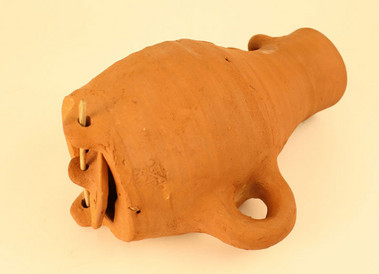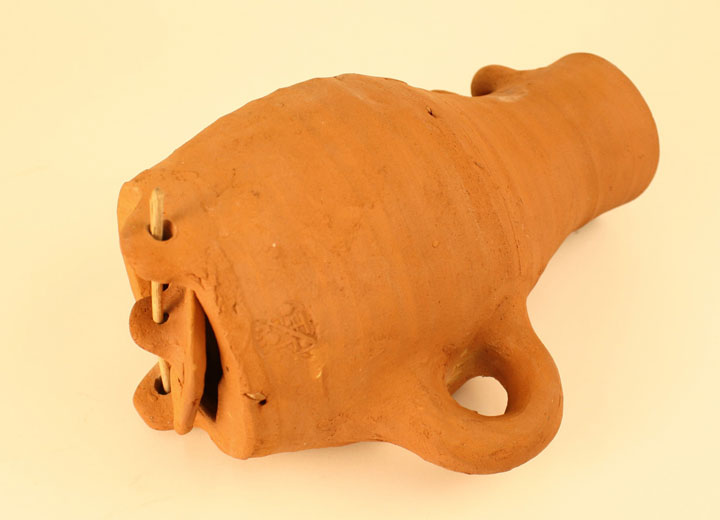Clay Bird's Nest, Medieval-Tudor, Replica
Unglazed earthenware object with a little hinged door secured by a twig. The nest has a large handle on the top and two smaller ones underneath on the neck. It is an example of a symbiotic relationship between humans and animals. In the late winter food could become very scarce in a medieval village and people risked starvation – crops stored over the winter were running low and there were, of course, no frozen or tinned foodstuffs to rely on. New planting may have begun but there would be nothing yet to harvest.
This nest could be hung up on the wall or under the eaves of the house. The clay provided well insulated container and birds were encouraged to nest in this readymade warm and secure space. Once the birds were established in the nest the little door at the back could be opened to remove any eggs or chicks for food. It sounds rather cruel but because the security of the clay nest encouraged the birds to lay eggs early in the spring, they would then be able to go on and raise another brood of chicks later on in the spring, keeping the bird population stable.
This is a historical replica inspired by original shards of similar nests found in northern Europe from East Anglia to Holland.You can see a clay nest like this in the top left corner of the drawing Caritas (Charity) by the Flemish artist Pieter Bruegel the Elder, 1559.

Length:28cm

Length:28cm

Unglazed earthenware object with a little hinged door secured by a twig. The nest has a large handle on the top and two smaller ones underneath on the neck. It is an example of a symbiotic relationship between humans and animals. In the late winter food could become very scarce in a medieval village and people risked starvation – crops stored over the winter were running low and there were, of course, no frozen or tinned foodstuffs to rely on. New planting may have begun but there would be nothing yet to harvest.
This nest could be hung up on the wall or under the eaves of the house. The clay provided well insulated container and birds were encouraged to nest in this readymade warm and secure space. Once the birds were established in the nest the little door at the back could be opened to remove any eggs or chicks for food. It sounds rather cruel but because the security of the clay nest encouraged the birds to lay eggs early in the spring, they would then be able to go on and raise another brood of chicks later on in the spring, keeping the bird population stable.
This is a historical replica inspired by original shards of similar nests found in northern Europe from East Anglia to Holland.You can see a clay nest like this in the top left corner of the drawing Caritas (Charity) by the Flemish artist Pieter Bruegel the Elder, 1559.




















